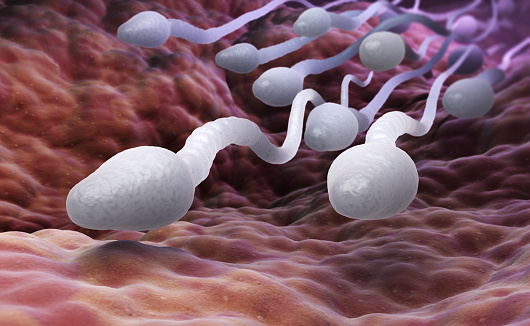Semen also known as seminal fluid which may be found in the form of liquid, smears or stains. It is a mixture of sperm, cells and various organic or inorganic materials.
It contains spermatozoa which is secreted by the seminal vesicles which is located in the pelvis, prostate and Cowper’s gland of males and can fertilize with female ova. It is gelatin like fluid containing several components as well spermatozoa; proteolytic, other enzymes, blood group factors. choline, citric acid, uric acid, zine and fructose are those elements which promote the survival of spermatozoa. The process of discharging of semen is known as “Ejaculation”. A normal man can ejaculate 5 ml of semen which contains about 100 million spermatozoa which are mobile for about 45 minutes to 3 hours after ejaculation. The weight of dry sperm is about seventy percent of the liquid sperm.
Morphology of Spermatozoa
Spermatozoa is a unicellular organism and has a specific morphological structure and identification in stain establishing its presence. The properties of shape and size of the sperm in humans are characteristics but only morphology cannot decide the individuality of a man Human spermatozoa vary in length from 50-55µ and consists of head, neck, midpiece and tail.

• Head-It in flat, oval and flexible and contains chromosomes. The diameter is 2.5-3.5 and length is 4-5. Anterior portion of the head is covered with cytoplasmic sheath which is known as Acrosome
• Neck-It contains one typical and one atypical centriole such as the proximal centriole like. It is very delicate and narrow which connects head and tail.
• Mid piece-It is characterized by a helical arrangement of mitochondria around a central pore, Mitochondria provide energy to sperm for locomotion.
• Tail – The tail is longer in length 45 50u. It contains flagellum or axial filament toprovide support and also helps in swimming in the female genital tract.
Some people’s semen does not carry any spermatozoon, which is called aspermic semen. The cause of that is some disease or may be due to vasectomy surgery. Comparison of pre or post vasectomy semen volumes reveals that about 90% of semen volume is made up of secretions from the accessory organs, mainly the Prostate and Seminal vesicles, with minor contributions from the Bulbourethral (Couper’s) gland and epididymides. In that case there is no chance of identification of semen. A reliable procedure for aspermic semen is immunological test using anti-semen serum against seminal plasma is being accepted. Most popular technique. Electrophoresis, is also reliable for the identification of the semen.
Enzymes and acid phosphatase present in seiten are in concentrations which are higher than present in other biological fluids. Acid phosphatase proposed a very considerate test for the location and identification of the semen but this is not giving a positive test alone.
There are two more components present in semen are Choline and Spermine and gives crystal test. Zinc, citric acid and fructose are either more or less not present in other body fluids and hence their exposure in semen should allow for its identification but these substances have not been implemented to be important enough to be noticed so far. The factors of blood grouping and other proteinaceous components have been used for blood grouping test of semen. They also carried out precipitin tests with stains of semen by using anti-semen serum prepared in the way anti-human blood serum is prepared.
The spermatozoon may be recognized with or without staining, but staining helps:
. Usually double staining with haematoxylin and eosin is done. In this way the nose is stained with pink and the rest of the head is stained with purple. This differential discriminates the spermatozoa from other organisms. Head can indicate stain.
• Leukocytes and epithelial cells in the excess amount, conceal the spermatozoa. The problem is dealing by staining the spermatozoa with malachite green and eosin. The process of interfering is greatly less in amount.
Constituents of Semen
Seminal plasma containing three major categories of components
• Low Molecular Weight Compound
• Enzymes
• Non-enzymatic Proteins
All proteins either possess an enzymatic activity or not are potentially antigenic. and preparation of antisera to plasma may contain antibodies to any of them. There are a number of antigenic proteins on the sperm cell, which may be intrinsic cellular constituents or seminal plasma proteins which have been absorbed into the cells. At the time of ejaculation, sperm passes through ejaculatory ducts and mises with fluids from the seminal vesicles, the prostate and the bulbourethral glands to form the semen. A yellow or grayish viscous fluid produced by the seminal vesicles which is rich in fructose and other materials makes about 75% of human semen. This composition of the semen varies from person to person.
• . The secretion of prostate, subjective by dihydrotestosterone is a white thin fluid containing proteolytic enzymes, citric acid, acid phosphatase and lipids.
• A clear secretion into the lumen od the urethra to lubricate it , secreted by the bulbourtethral.
• Sertoli cells, which nurture and support producing spermatocytes, secrete a fluid into seminiferous tubules that helps transport spermatozoa to the female genital ducts.
Characteristics of Semen
Individualization
Semen is unique in its characteristics in each individual. It is not possible to identity the individuality of semen of a particular person by general methods but it can be possible that DNA profiling to identify source of origin either from a tiny spot or even when contaminated 7/47 with vaginal secretion or from other sources.
Age of Seminal Fluid
It is also not possible to determine because of the environmental conditions. It liquifies when it ejaculates When drying, it turns to an opaque white mass with a rough feel, Its color changes from pale yellow to brown after two or three weeks. When semen is fresh in condition the spermatozoa is complete with head and tail while on drying with the passage of time, head and tail are disintegrated
Lifespan of Spermatozoa
The spermatozoa remains movable only for a few hours under normal conditions and it continues after twenty-four hours. The spermatozoa is alive for a long time when it is frozen and when it is brought to normal temperature, it again shows motility. The spermatozoa get destroyed in warm and humed climates whereas it may be detected in cool and dry climates after a few months Evrand (1971) said that motile sperm could survive up to ninety-six hours in the vagina.
The spermatozoa may be detected up to five to ten days from the vaginal swab of a living person. But in the case of a dead person, its detection depends upon the condition where the dead body was kept. It may be detected from unputrefied body after a few months whereas it destroyed in putrefied body. Apart from these, we can also distinguish serminal fluid on the basis of its physical, chemical and biological characteristics
Physical Characteristics
The average physical properties of semen include-color, smell, specific gravity, pH. viscosity, buffering capacity and volume. The ranges of physical properties of the semen are shown below:
Table No. 1-Description of Physical Properties
| PROPERTY | DESCRIPTION |
| Color | White or Opalescent. |
| Smell | A chlorine smell or fishy odour. |
| Specific Gravity | It ranges between 1.020 and 1.040 in human semen |
| pH | The pit depends on length of time since ejaculation and it increases shortly after ejaculation as a loss of carbon dioxide. It ranges from 7-2 8.2 in seminal fluid |
| Buffering capacity | It is much higher in semen than that of other body fluids. The average buffering capacity in physiologic range is 41.1 which is significantly higher than that in serums 23,3. |
| Volume | The average volume of semen produced at ejaculation ranges from 2-5ml. |
Chemical Characteristics
At the time of ejaculation, sperm passes through ejaculatory ducts and mixed with fluids from seminal vesicles, prostate and the Cowper’s glands to form semen.
| GLANDS | VOLUME IN EJACULATES | DESCRIPTION |
| Testes | 0.17 ml (3%) | Producing and storing Sperm, contains approximately 30 million spermatozoa. |
| Seminal Vesicles | 1.8-2.5 ml (66%) | Store and produce the fluids that make up semen It comains fructose, phosphorylcholine, ascorbic acid, prostaglandins, bicarbonate |
| Prostate | 07-09 ml (30%) | It’s function is to secret prostate fluid and also contains spermine prostate, cholesterol, citric acid, phosphatase, phospholipids, etc. |
| Cowper’s Gland | <1% | Contains Mucus, Galactose. Sialic Acid etc. |
Fore more updates , subscribe to our blog.









